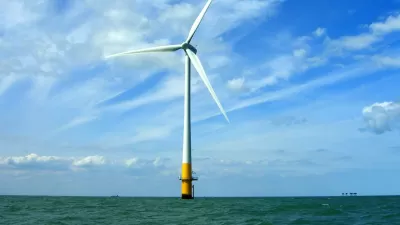Elizabeth City, North Carolina, will host a 204-megawatt wind energy facility—the first in a region known for steady coastal breezes. The project is a collaboration of European-based Iberdrola Renewables, LLC, and Seattle-based Amazon.
The $600 million project includes 102 turbines on 22,000 acres, to be built by Spanish developer Iberdrola Renewables, LLC. It will generate enough electricity to power about 60,000 homes, though the electricity will not be used locally. Iberdrola has partnered with Seattle-based Amazon as its sole customer, and the project will help support the retail giant's cloud-computing division, Amazon Web Services. Power from the Elizabeth City project will be sent to regional transmission lines, feeding Amazon’s data centers in Virginia and Ohio.
Currently there are no commercial wind energy farms in a region of nine southeast states, according to data from the American Wind Energy Association, an industry trade group. Part of the reason the southeast has been passed over by the wind energy industry is because the winds were not thought to be strong enough. But newer designs allow for taller turbines with bigger blades, which are able to capture stronger breezes and could help turn the industry’s attention toward the region for further exploration.

Wind energy also faces political challenges in the southeast, and the success of Iberdrola and Amazon could create smoother sailing for future projects. North Carolina in particular is considered to have some of region’s best winds, but proposals in the past have been pushed out due to opposition from tourism groups, interference with military flight paths, and potential harm to wildlife.
FULL STORY: South getting its first big wind farm soon

Study: Maui’s Plan to Convert Vacation Rentals to Long-Term Housing Could Cause Nearly $1 Billion Economic Loss
The plan would reduce visitor accommodation by 25,% resulting in 1,900 jobs lost.

North Texas Transit Leaders Tout Benefits of TOD for Growing Region
At a summit focused on transit-oriented development, policymakers discussed how North Texas’ expanded light rail system can serve as a tool for economic growth.

Using Old Oil and Gas Wells for Green Energy Storage
Penn State researchers have found that repurposing abandoned oil and gas wells for geothermal-assisted compressed-air energy storage can boost efficiency, reduce environmental risks, and support clean energy and job transitions.

Private Donations Propel Early Restoration of Palisades Playground
Los Angeles has secured over $1.3 million in private funding to restore the Pacific Palisades playground months ahead of schedule, creating a modern, accessible space that supports community healing after recent wildfires.

From Blight to Benefit: Early Results From California’s Equitable Cleanup Program
The Equitable Community Revitalization Grant (ECRG) program is reshaping brownfield redevelopment by prioritizing projects in low-income and environmental justice communities, emphasizing equity, transparency, and community benefits.

Planting Relief: Tackling Las Vegas Heat One Tree at a Time
Nevada Plants, a Las Vegas-based nonprofit, is combating the city’s extreme urban heat by giving away trees to residents in underserved neighborhoods, promoting shade, sustainability, and community health.
Urban Design for Planners 1: Software Tools
This six-course series explores essential urban design concepts using open source software and equips planners with the tools they need to participate fully in the urban design process.
Planning for Universal Design
Learn the tools for implementing Universal Design in planning regulations.
Ascent Environmental
Borough of Carlisle
Institute for Housing and Urban Development Studies (IHS)
City of Grandview
Harvard GSD Executive Education
Toledo-Lucas County Plan Commissions
Salt Lake City
NYU Wagner Graduate School of Public Service





























